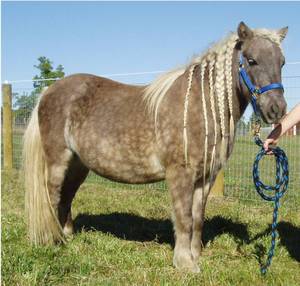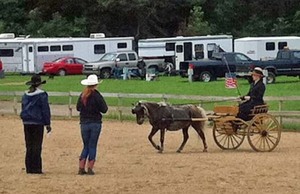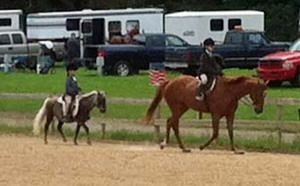Shetland ponies can make excellent mounts for children, but they need a good education

Shetland pony, Cheyenne.
Kathy Lundberg | Contributor
Shetland ponies have a high cuteness factor, but pound for pound, they are the most powerful of all equines.
As sweet as they appear, and as capable as they are, it takes years of education to make a good riding pony.
The theory about the origin of this breed is that equines were in the process of evolving into different species as they spread across Eurasia from their North American origins, adapting to habitats from desert to tundra along the way. Far north in western Europe — under pressure of rocky terrain, bitter cold, long winters, and often severely limited food supply — ponies grew smaller and tougher.
The most dramatic of these influences resulted in the Shetland Pony. People came along and domesticated ponies and horses, mixing and genetically engineering them for various purposes. Distinctions between horse and pony types blurred. Geographically isolated, Shetland ponies have retained much of their original characteristics.
Shetland ponies have worked the land on farms and under it in mines. Today they are mainly ridden by children, are excellent in harness and also work in circuses. This is the story of one Shetland gelding named Cheyenne.
Cheyenne was purchased in the summer of 2005 to be a lesson pony. By veterinarian dental exam, he was determined to be about 12 years old at that time. Recent dental examination estimated his age as 12 years old at this time — six years later (In other words, his age is unknown.).
He was bought from a man who raised and worked ponies for pony rides, and had become chronically unwell. The ponies were running amok, with little work and several unplanned pregnancies.

Judge (dark hat) appraises driving contestants, assisted by Ring Steward (light hat).
Kathy Lundberg | Contributor
The basic skills required of a pony ride animal are to be quiet while in a harness or under a saddle and to walk while led in circle after circle. It is rather dull work, but ponies get to hang around other ponies and basically move as a team.
A riding pony, on the other hand, must independently walk, trot, canter, jump, turn and, importantly, stop at the request of a small child. Big difference.
I will remind kind readers that ponies are mature, adult animals with their own perspectives, instincts and motives. They possess “pony attitude.”
It is actually not easy to train a good riding pony, especially a mature adult. What you need is a strong little rider with steely nerves who is motivated to make that pony his or her own and some capable adult help. Fortunately for Cheyenne, just such an 8-year-old rider devoted herself to his improvement.

Cheyenne and his new girl compete in Hunt Seat.
Kathy Lundberg | Contributor
First, Cheyenne needed to learn to take direction under saddle and bridle. All gates had to be completely closed, or he would bolt out to the nearest blade of grass and stop short.
Then came trotting. Pony trot is a rapid staccato; a fast pony-trot will bounce most children right off. Once the trot was moderated, he was taught to canter under saddle.
Early cantering was generally preceeded by crazily fast trotting punctuated by bouts of rodeo bucking. It kind of looked funny, but it really was not.
Eventually, Cheyenne became a solid citizen. He has been trail riding, gone fox hunting and has been shown jumping and on the flat. Kids often subscribe to the “bigger is better” idea, and even the smallest of children pine to ride a “big horse,” but few children ever become skilled enough to take full advantage of Cheyenne’s capabilities.
The day came when Cheyenne’s rider became too big to continue riding and jumping with him, and she moved on to a larger pony. Cheyenne was devoted to riding lessons, and has taught many children to ride.
“His girl” never lost interest in him, and campaigned for a year before her parents succumbed to relentless requests for a small cart. Cheyenne learned to drive with the capable help of the good people at Odyssey Training Center.
On Sunday, Cheyenne was loaded into a trailer, along with a young Shetland just beginning his career, behind a two-wheeled wooden cart. They spent the day at the Lower Michigan Horse Association show in Mason.
Cheyenne was shown in Showmanship, Driving, In-Hand Pony Jumping, English Pleasure and Equitation by “his girl” and her young protégé. They won ribbons in each class — several blue.
The young pony was shown only in a halter class (stand and look pretty, judged on body build), and carried on so dramatically that his showmanship and trail classes were scratched. He is a long way from being the “push-button” pony Cheyenne is, but with time, patience, continued exposure to new things, and a little love, he will be there some day.
Kathy Lundberg is a regular pets contributor for AnnArbor.com, and owner of Scio Church Stables. Email her at scs@sciochurchstables.com.


Comments
RunsWithScissors
Thu, Jun 16, 2011 : 1:55 a.m.
Many horse trainers can testify that if you can ride/train a Shetland, then you're ready to work with the other breeds. My most challenging and rewarding experiences have been working with Shetlands. Nice article.
Elli Schmidt
Wed, Jun 15, 2011 : 4:22 p.m.
What a nice post! I grew up with a black Shetland mare and had her for over 25 years. We learned together to ride and to drive and went out for hacks and carriage drives ever so often. The nicest has been sledge rides, where we got her in front of an old log sledge and went out to get hay. Shetlands are so versatile and tough that is unbelieveable. She hardly ever needed veterinary care, only the annual jabs and regular hoof rasps. I think they are ideal for children, if a caring, horse-crazy parent is always there in the background. Otherwise, they can become quite dominant, as they have got their own "head". They are tough ponies, but this doesn't mean they can be neglected. They don't need fancy feed, but they need attention and should be cared for regularly. If hooves, teeth and jabs are looked after well, they acn reach very old age. I started my own "pony project" on <a href="http://www.ponypress.org" rel='nofollow'>http://www.ponypress.org</a> and you are invited to check it out and leave feedback :) Thanks, Ellen - <a href="http://www.ponypress.org" rel='nofollow'>www.ponypress.org</a>